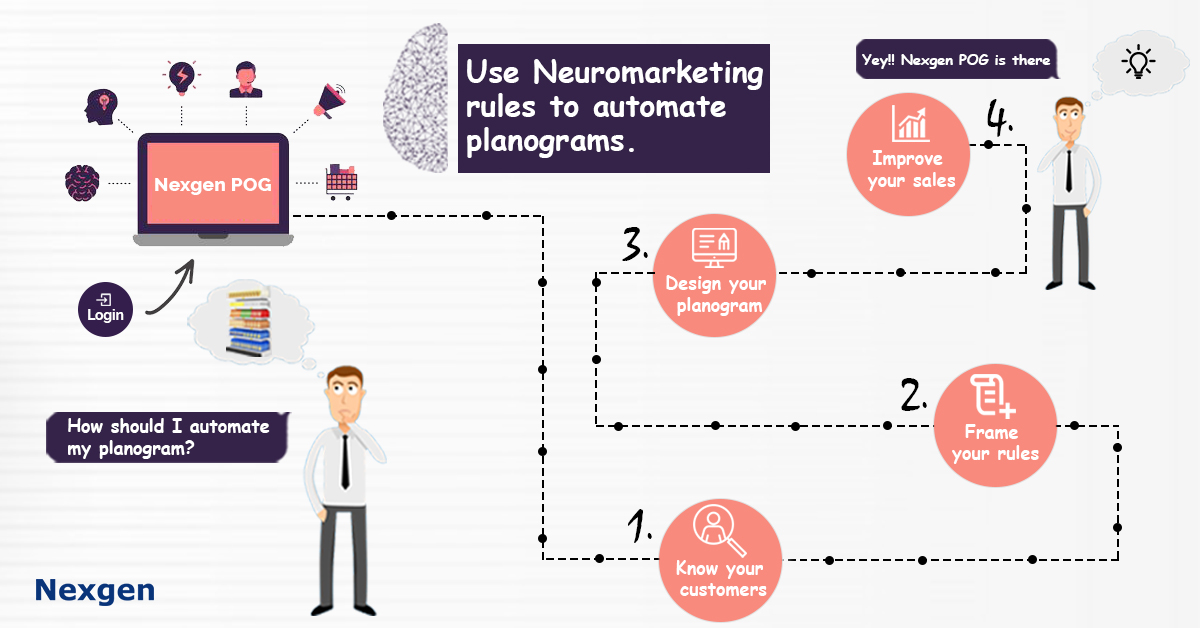Neuromarketing is the application of neuroscience to marketing. It includes the use of brain imaging, scanning, other brain activity and response to specific products, packaging, advertising, or other marketing elements. Visual merchandising efforts can be designed using the ways in which the brain works and process information.
How can planogramming benefit from neuromarketing?
Given planogramming is a visual merchandising method used to attract customers. Knowing about the mental processing of the information is important to consider before designing the planogram to make the marketing efforts effective on the target customers.
The rules evolved from neuromarketing that can be used in planogramming include:
Catchy color, Line of sight, eye scanning pattern, scarcity creation, positioning of products, product grouping based on brand, color, category, manufacturer, flavor, etc. Merchandising the shelf space should be done with care and after considering the rational thinking pattern of human beings. Two effective methods for tracking human behavior in response to marketing efforts is to do
- Electroencephalogram (EEG)
- Eye tracking
<iframe width="700" height="315" src="https://www.youtube.com/embed/oKgi3SYA7wU" frameborder="0" allow="accelerometer; autoplay; encrypted-media; gyroscope; picture-in-picture" allowfullscreen></iframe>
EEG will analyze the impact of the overall appeal of the shelf and behavioral patterns of the shopper. The important insights for a retail planogram designer from this are:
- Categorization
- Workload regulation
- Visibility
- Distraction
The shopper should be able to find the required products easily. One method which helps in improving the appeal of the visual merchandising displays is categorizing the products. The products can be categorized based on the type of product (drinks, food items, cosmetics, etc.), health benefits (low fat, no trans-fat, nutritional, etc.), flavor, etc. A planogram designer can use product blocks which help the shoppers to identify the products based on brand, manufacturer, flavor, health benefits, etc. This will help easy shopping and reduce workload.
Another important fact to be considered is managing visibility. The product must be made sufficiently visible. Product the shopper looking for can be found only when enough facing is provided in designing the planogram. The single facing product will be difficult to find compared to the product having 3-4 facing on the shelf. A shopper entering a retail store can get distracted with other products, it is good up to a certain extent. However, the planogram designer should take extra effort to avoid excessive distraction to avoid confusing the shopper.
Eye tracking will help in detecting the
- shopping hot spots.
- scanning pattern

It helps to identify the areas where the most desired position of the shelf is and places where shopper’s eye doesn’t reach. As most of the planogram designers know eye-level shelf have high product movement and endcap displays and packaging design and suitable arrangement of product attract customers. By identifying this the planogram designer can design the planogram by placing low sales or high priority items in the shopping hot spots. Eye tracking also helps in identifying the eye scanning pattern. Shoppers tend to scan horizontally from left to right to find the category in which they are interested in. After finding the category the shopper tends to do vertical scanning to select the desired product in the category. This helps in designing the brand blocking possibilities for a planogram designer.
Nexgen POG is a user-friendly and easy planogram solution. It is cost effective and allows controlled access and planogram sharing. Nexgen POG also provides multiple analysis options and planogram compliances option. Import of planogram from excel, PSA, XML formats possible. Nexgen POG will make your planogram development, sharing, editing, and compliance easy.
Why wait anymore! Get your Free Trial Now!